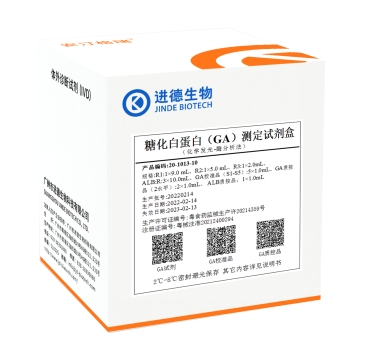GA(糖化白蛋白)
Glycated Albumin Chemiluminescent Enzymatic Assay

☑️ Description
Glycated albumin (GA) is an intermediate glycemic control maker (preceding two to three weeks) used in the glycemic control of patients with diabetes.
1)Albumin is a protein that can be easily glycated.
2)GA is an intermediate term (preceding two to three weeks) glycemic control marker used to confirm the therapeutic effect.
☑️ How Does it Work?
GA is a ketoamine formed via a non-enzymatic glycation reaction of serum albumin and it reflects mean glycemia over two to three weeks. GA can be used for patients with anemia or hemoglobinopathies for whom the clinically measured hemoglobin A1c level may be inaccurate. Because both serum and plasma samples can be used, GA can be analyzed from the same samples as common biological markers. GA is a useful marker for the screening of diabetes in a medical evaluation. It can be also used to determine the effectiveness of treatment before initiating or changing medications for diabetic patients. GA is potentially an atherogenic protein in the development of diabetic atherosclerosis.GA measurement is useful as part of a routine examination to screen for both diabetes and atherosclerosis.
GA is a short-term marker of glycemia that has been evaluated as an alternative test to A1C in patients with DM. If compared to A1C, GA is more reliable to evaluate glycemic variability. Also, it is especially indicated for patients on hemodialysis and its levels are not affected in the presence of anemias or hemolytic processes. Compared to the fructosamine test, GA is more advantageous, since it is not influenced by other serum proteins. The enzymatic methodology for its analysis is easy and quick to implement, and highly efficient analytically and with greater standardization. As previously described, in clinical situations that falsely alter A1C levels, the measurement of GA may assign a reliable result for monitoring DM. However, the physiology of the formation of these two glycated proteins ensures advantages to GA compared to A1C in access glucose control, even in the absence of interfering factors. Finally, many studies have shown that GA has good diagnostic accuracy and is strongly associated with the diabetic microvascular complications. Despite all benefits of GA, it does not replace the use of A1C, once each test has its advantages and limitations. The choice regarding which test to use should be guided by the clinical patient features and tests availability. Further, it is necessary an international consensus about laboratory issues and clinical use of GA, to guarantee its inclusion in the routine of clinical laboratory worldwide, thus improving the future screening and management of DM patients.
☑️ The GA Test:
1)GA increases in hyperglycemia and reflects glycemia over 2–3 weeks.
2)A user friendly and automated enzymatic assay for measuring GA is available.
3)GA is a useful marker for the screening of diabetes in a routine medical evaluation.
4)GA is useful for postprandial hyperglycemia and glycemic fluctuation.
5)GA is potentially an atherogenic protein in diabetic atherosclerosis.
Contact Us
Follow us
 Wechat
Wechat

